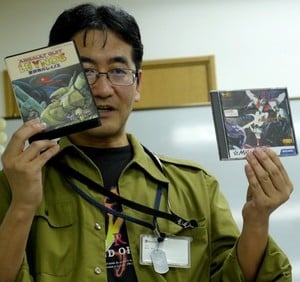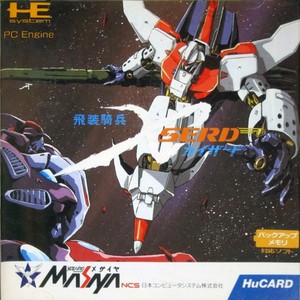
You know how the Wonder Boy and Adventure Island series are both distinct, yet interlinked and extremely convoluted as a result? Well, it's a similar situation with the Juussou Kihei series (AKA: Assault Suits series) and the Front Mission series. You probably know the Juusou Kihei series due to Assault Suit Leynos / Target Earth on Mega Drive (1990) and Assault Suits Valken / Cybernator on SNES (1992).
Fans of this series and Front Mission will have noticed similarities between Valken and Front Mission: Gun Hazard on Super Famicom (1996). These are not coincidences, nor is it simply inspiration or a homage - the two series share a precursor. This gets a little complicated, so we're going to walk through it slowly, sticking to the original Japanese names. Please excuse us if we repeat ourselves.
Disentangling these convoluted dynasties is possible thanks to a four-and-a-half-hour interview with Masayuki Suzuki and Satoshi Nakai for The Untold History of Japanese Game Developers Volume 2 (totalling 22,800 words spread over 40 pages). The careers of Suzuki and Nakai are too prolific to summarise, but they worked on the Leynos and Valken games, respectively; Suzuki also created the Langrisser / Warsong series, while Nakai worked on Gynoug / Wings of Wor and Code Veronica. We discussed every topic on every game. Joseph Redon of the Japanese Game Preservation Society brought boxes filled with every title they'd worked on; Nakai brought all of his original art; Suzuki wore his rare Langrisser t-shirt. History was documented and made that day.
At one point, we asked Nakai about his involvement with Gun Hazard since he did the graphics, also enemy, background, and level design. Our assumption being that Gun Hazard was inspired by his earlier work on Valken; the main difference is that Valken was developed at NCS / Masaya, while Gun Hazard was developed at Omiya Soft.
"We wanted to do a sequel to Valken, on a larger scale," admits Nakai, confirming what everyone knew. "We thought that some role-playing elements were needed to extend the play time. We discussed this from the beginning. Personally, I wanted to design something bigger, something more amazing that I wasn't able to do in Valken, like larger enemy characters. More generally, I wanted to create the sense of destroying things on a larger scale. It was a unique entry in the Front Mission series. There was a producer at Square, Toshirou Tsuchida, who had previously left Masaya."
If you look up Tsuchida's profile on MobyGames, his portfolio is enormous, encompassing numerous retro classics, and includes credits on Valken and six different Front Mission games, starting with the first. Curiously, he's not actually credited on Gun Hazard, despite Nakai attributing the formation of its dev team to him.
"Tsuchida-san from Square had a conversation with Omiya Soft," explains Nakai. "Through that process, they arranged for the developers who had created the graphics and program for Valken to work on a new title attached to one of Square's brands, and make one of the last big action games for the Super Famicom."

So far we've confirmed that Valken and Gun Hazard shared staff, and that the original Front Mission producer, Tsuchida, deliberately courted Omiya Soft to make an action game similar to Valken under the Front Mission label. This seems straightforward enough, but the connection runs so much deeper.
"Backing up a little bit!" interrupts Suzuki, grabbing copies of Leynos and a PC Engine game called Hisou Kihei X-Serd off the table. He's about to make our brains melt, "First of all, Tsuchida-san created this, a strategy game... <humorous tone> Oh, that's right! These two games are brothers!"
Suzuki holds aloft the two games, side by side. The PC Engine strategy game is the somewhat obscure Hisou Kihei Kai-Serd, released in February 1990. A lot of places Romanise it 'X-Serd', which is incorrect given that the katakana spells "kai", but doing a conversion on "kai" shows the symbol ( χ ) in the list of possible kanji symbols on OSX. The character maps to the Greek small letter "chi" in Unicode. So it looks like X-Serd – and we're going to refer to it as X-Serd – but in Japan, you pronounce it Kai-Serd.

Hisou Kihei X-Serd ( 飛装騎兵 カイザード ) roughly translates to "Flying Cavalry Soldier: X-Serd"; the second symbol meaning outfit ( 装 ) and the fourth symbol meaning soldier ( 兵 ) are also the same for Leynos and Valken, whose titles ( 重装機兵 / Juussou Kihei ) start "Heavy Machine Soldier". Serd is the name of the robot weapons used, and turns up again in the Mega Drive sequel Vixen 357 (1992). We're not getting into Vixen 357 because this family reunion is crowded as is, but keep it in mind.
"Originally," says Suzuki, taking a deep breath as he's about to explain how X-Serd and Leynos are related, "the idea was to do a huge project encompassing a strategy version and an action version released at the same time, with a crossover story between the two titles. So you would have an action game (Leynos) and a strategy game (X-Serd) set in the same universe, released on the Mega Drive and the PC Engine, respectively. But because of various circumstances, the games diverged into their own universes. This one, Leynos, was programmed by Hideo Suzuki,* who much later went to Omiya Soft, while Tsuchida-san acted as the producer for this one, X-Serd. After that, Tsuchida-san left Masaya and went to Square, where he created another robot strategy game, Front Mission. Meanwhile, Hideo Suzuki remained at Masaya and created Valken."





